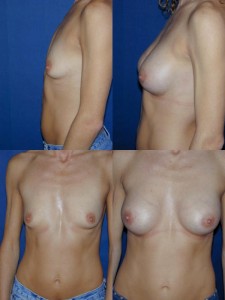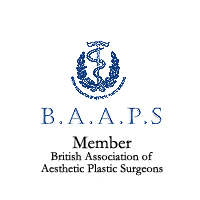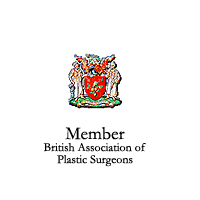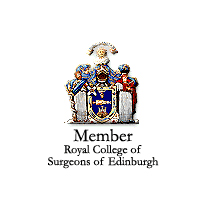Introduction
This operation is designed to increase the size of the breasts, but does not really lift the nipple and existing breasts for which a different operation is required. This operation is therefore suitable for people who have naturally small breasts, or those whose breasts have shrunk in size following a pregnancy. If a further pregnancy should occur after breast augmentation, particular care should be taken in supporting the breasts in order to maintain the best possible shape.
An implant of suitable size is either placed directly behind the breast tissue or behind the muscle in order to leave the normal breast in front. Lactation is usually not interfered with and sensation kept as normal in the vast majority of patients.
Operation
The operation is carried out through a one and a half inch incision (3-5 cm approx.) in a position that is often optional. It is technically possible to choose from three different sites for access although this depends on the size and style of the implant:
- Axilla: The hair bearing skin of the axillae, where it is well concealed.
- The sub-mammary crease:Just at the level of the natural fold under the breast.
- The areola:Half a circumference around the nipple.
The breasts may feel sore the day after the operation, particularly when the arms are moved, but this soreness rapidly improves on the second day.
You will be given an appointment to remove the adhesive dressing and you will be instructed in the further care of your breasts. Three weeks after your operation, you may resume gentle exercise, but violent movement and upward stretching of the arms is inadvisable for six weeks. The type of brassiere after the operation is important, and should not allow upward displacement of the implants in the first six weeks after surgery. You will be advised regarding the most suitable type for you.
Long Term Results
The material of the implants varies, although silicone implants have been used for over thirty years with no evidence relating to cancer with silicone implants.
It is however advisable to wear a supporting brassiere most of the day, as applies to any un-operated breast, this minimizes the stretching of the skin over the years.
The lifespan of an implant is variable. An average of 10 to 15 years is generally accepted before the need of revision surgery, this might be the replacement or removal of the implant with or without the uplift of the breast.
Hardening of the breast may develop in 7-10% of patients due to scar formation around the implant. The exact cause of this problem in a few patients is not fully understood, but presumably is caused by abnormal sensitivity to the otherwise inert breast implant.
It is necessary to stress the possibility of complications, such as bleeding, infection, the hardening previously mentioned, and implant displacement but in my practice this is very rare and I regard breast augmentation as a highly satisfactory operation when the need is indicated.
After the operation you will be visited whilst in hospital by myself, or otherwise a member of my team in order to ensure a personal and confidential programme of after care. I can be contacted through my secretary, or out of hours, the Hospital switchboard should the need arise.
Revision surgery may be required in a very small minority of cases in the short term. In these circumstances you will not incur any surgical fees (payment to the surgeon), but you will be responsible for the cost of the hospital, cost of the implants and anaesthetic fees.
It is important to note that a more in detail discussion about the operation and possible complications adjusted to your specific needs takes place during consultation.
In general we do advise that you do not drive for 2 weeks after breast augmentation.
All prosthesis are a silicone bag. Two fillers are used:
Saline: Water with salt.
Silicone gel: Soft liquid or Cohesive jelly inside silicone coating.
Saline filled implants: Widely used in USA. Can not overfill (this results in wrinkles). Wrinkles can show through breast. Wrinkles imply weakness points, and this leads to increase rate of rupture and the subsequent need for replacement. Rupture is not dangerous as the fluid is simply reabsorbed, but requires replacement (additional cost).
Silicone-Gel filled implants: Used for over 40 years in breast augmentation. Multitude studies and analysis amongst thousands of patients in the USA and the UK have shown no link between silicone breast implants and any of the following: 2. Congenital abnormalities in children. 3. Range of diseases from ME to ARTHRITIS, called connective tissue diseases. It does not cause breast cancer.
The questions on Cancer – Silicone: Results of long term screening in USA show ladies with silicone implants have a decreased risk of breast cancer. Silicone does interfere with mammograms therefore different views are arranged when the implant is situated under breast gland. Implants can be placed under the muscle. Always tell the Doctor when you are examined that you have breast implants. Patients who develop breast cancer (1 in 15 females) , if they have a breast implant do not have worse prognosis than otherwise.
Silicone implants and pregnancy: Everyone agrees that silicone has no effect on conception or the growth of your baby. You can safely breast feed.
Connective tissue disease: 23 Studies through the world comparing matched pairs of ladies: One with bilateral silicone augmentations and the other with no breast operation. The diseases, aches, pains, etc were the same in each group. There is no statistical evidence linking silicone to causing diseases: This has been stablished in the USA (courts) and in the UK (Government independent review).
Mr. Matti uses a wide range of implants. Breast implants have greatly improved in design over the last three decades to best suit the individual patient. Modern implants are available in many different shapes (anatomical or rounded) and dimensions.
In the consultations Mr. Matti will help with you to decide what is the most suitable type of prosthesis for your specific needs. We will be delighted to help you solve any questions you may have regarding this subject of breast prosthesis.












